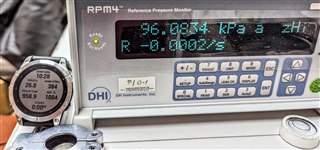EDIT: Added TEMP test too.
Today I tried to compare F7 standard barometer with calibrated proffesional pressure monitor. I also compared the watch of colleagues - Amazfit GTR4 and older Honor watch GS Pro.
Measured "right" value was 960.8hPa
1st. place for Amazfit GTR4 with 961hPa (doesn´t show decimals)
2nd. place Honor watch GS Pro with 960hPa (doesn´t show decimals)
3rd. place F7 with 958.9hPa
When I owned F7Pro solar for two weeks, it shows 1hPa higher than my F7. So it was closer to the reference. In the end it doesn´t matter, because the trend is more important than real value, but if there was a possibility to add offset in some menu, it could be able to show perfectly accurate value :-).
I´m going to do some next temperature measurent tests in temperature chamber. Will post later :-).




